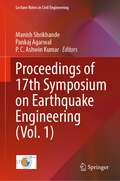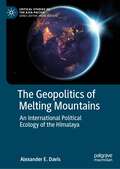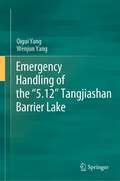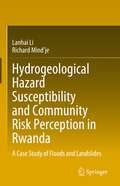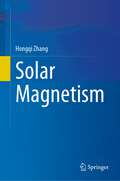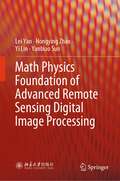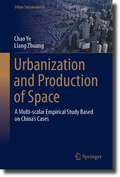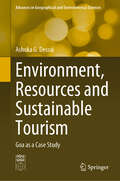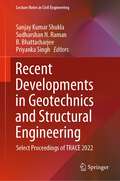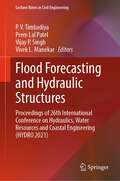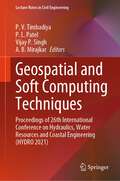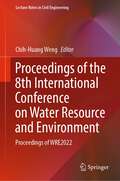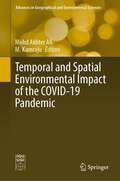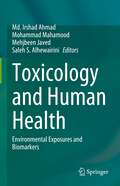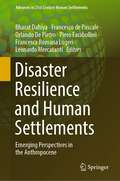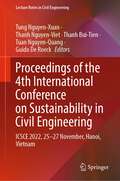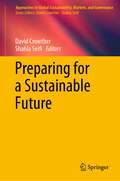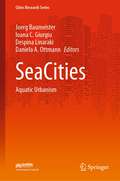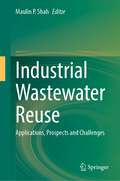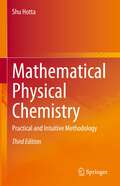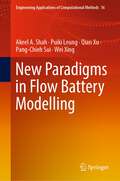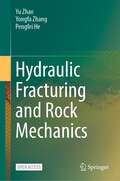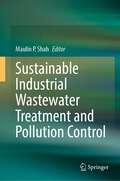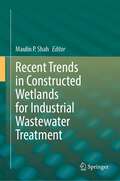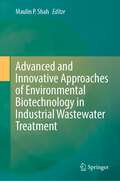- Table View
- List View
Proceedings of 17th Symposium on Earthquake Engineering (Lecture Notes in Civil Engineering #329)
by Manish Shrikhande Pankaj Agarwal P. C. Ashwin KumarThis book presents select proceedings of the 17th Symposium on Earthquake Engineering organized by the Department of Earthquake Engineering, Indian Institute of Technology Roorkee. The topics covered in the proceedings include engineering seismology and seismotectonics, earthquake hazard assessment, seismic microzonation and urban planning, dynamic properties of soils and ground response, ground improvement techniques for seismic hazards, computational soil dynamics, dynamic soil–structure interaction, codal provisions on earthquake-resistant design, seismic evaluation and retrofitting of structures, earthquake disaster mitigation and management, and many more. This book also discusses relevant issues related to earthquakes, such as human response and socioeconomic matters, post-earthquake rehabilitation, earthquake engineering education, public awareness, participation and enforcement of building safety laws, and earthquake prediction and early warning system. This book is a valuable reference for researchers and professionals working in the area of earthquake engineering.
The Geopolitics of Melting Mountains: An International Political Ecology of the Himalaya (Critical Studies of the Asia-Pacific)
by Alexander E. DavisThe book addresses the urgent need for rethinking the geopolitics and ecology in the Himalaya, by emphasising the entanglements between these two factors. Most international relations analyses of the Himalaya emphasize the central role of the region’s states and their great power struggles. By reducing the region to its state actors, however, we miss the intense more-than-human diversity of the region, and the crucial role that the mountains play in the global environment. In doing so, the book makes a major contribution to international relations theory by drawing on insights from international political ecology. It first theorises international political ecology and examines the Himalaya as a global region, before moving looking at the international aspects of political ecology in the Himalaya through key areas of the mountains where international politics and ecology are deeply, inextricably linked. It presents three detailed case studies of different environmental and political issues in the Himalaya: icecaps (the India-China-Pakistan boundary dispute in the western Himalaya), foothills and forests (the Nepal-Bhutan-Sikkim borderlands), and rivers (the India-China Bangladesh dispute over the Brahmaputra River basin). Each case study draws on a mix of source materials including fieldwork, government sources, foreign policy discourse, Himalayan ethnographies, and environmental and ecological sciences scholarship.
Emergency Handling of the “5.12” Tangjiashan Barrier Lake
by Qigui Yang Wenjun YangThis book introduces emergency management of barrier lakes systematically,including theories and practices, risk assessment under extremely high-riskconditions, evolution of outburst floods, analysis of anti-impact stability, andemergency management technology and assessment of risk elimination effect.It takes the Tangjiashan barrier lake as a successful case study toillustrate effective treatment of barrier lake with high risks, poor environmentalconditions, extremely urgent rescue time and high disposal difficulties. Itretains a large number of images and data of great research value for the lakerisk assessment and building technological emergency system. It provides areliable reference for the government, scientific researchers and survey anddesign team to deal with the sudden natural disaster in barrier lakes,especially caused by huge earthquake.
Hydrogeological Hazard Susceptibility and Community Risk Perception in Rwanda: A Case Study Of Floods And Landslides
by Lanhai Li Richard Mind’jeSolar Magnetism
by Hongqi ZhangThis book highlights fundamentals and advances in the theories and observations of solar magnetic fields. Solar magnetism is an important part of solar physics and space weather research. It covers the formation, development, and relaxation of the magnetic fields in the solar eruptive process. The book discusses topics ranging from measurement facilities for solar observations to the evolution of solar magnetic fields, the storage of magnetic energy, and the magnetic helicity in the solar atmosphere and its relation with solar cycles. The book also presents recent advances in measurements and observations of solar magnetic shear, currents, magnetic helicity, and solar cycles. The book intends for astronomy-majored students and researchers interested in solar magnetism and its role in astrophysics.
Math Physics Foundation of Advanced Remote Sensing Digital Image Processing
by Lei Yan Hongying Zhao Yi Lin Yanbiao SunThis book focuses on the mathematical and physical foundations of remote sensing digital image processing and introduces key algorithms utilized in this area. The book fully introduces the basic mathematical and physical process of digital imaging, the basic theory and algorithm of pixel image processing, and the higher-order image processing algorithm and its application. This book skillfully and closely integrates theory, algorithms, and applications, making it simple for readers to understand and use. Researchers and students working in the fields of remote sensing, computer vision, geographic information science, electronic information, etc., can profit from this book. For their work and research in digital image processing, they can master the fundamentals of imaging and image processing techniques.
Urbanization and Production of Space: A Multi-scalar Empirical Study Based on China's Cases (Urban Sustainability)
by Chao Ye Liang ZhuangThis book studies China’s urbanization with the theory of production of space. The authors redefine the production of space and build a new theoretical framework for understanding the evolving relations between urbanization and spatial production. Since the reform and opening-up, especially in the last twenty years, the logic of spatial production has dominated China’s urbanization. The authors choose the most representative cases, such as the Yangtze River Delta Urban Agglomeration, Jiangsu Province, National High-tech Industrial Development Zone, New Urban District, State-Level New Area, University Town, and some villages, to conduct a series of empirical studies on production of space at the macro-, meso-, and micro-scales. Through an in-depth analysis of the interaction between social spaces and urbanization influenced by power, capital, and class, the book reveals that the essence of China’s urbanization is dominated by the logic of spatial production. The authors finally propose that an important shift toward humanism should be made in the future development of China’s new-type urbanization, emphasizing more even and adequate development between different regions and between urban and rural areas, which also provides new ideas for the theory and practice of urbanization worldwide.This book can be read and referenced by researchers in the fields of urban and regional studies, geography, sociology, urban and rural planning, management, etc. It can also be used as a teaching reference book for teachers, researchers, and students of scientific research institutions in related fields.
Environment, Resources and Sustainable Tourism: Goa as a Case Study (Advances in Geographical and Environmental Sciences)
by Ashoka G. DessaiThis book suggests sustainable economy from the viewpoint of tourism fostering low carbon footprint. Focussed on conserving heritage, culture and endemic biota of a crucial biodiversity hotspot of the world, the book discusses the impact of a large population, fast-paced development and excessive consumption of earth resources by tourism in a developing economy. The book (i) assesses the impact of overexploitation of earth resources on environmental components such as air, water, land and people, (ii) examines the sustainability of tourism on the physical, economic and socio-cultural environment including human lifestyles, (iii) presents the potential of tourism in promoting sustainable development, poverty alleviation and conservation of nature and (iv) formulates recommendations for tourism, fostering sustainable development in Goa, India. The book offers students, researchers, academics and professionals a comprehensive discourse integrating geological and societal perspectives on core issues. It generates critical thinking on the complex issue of sustainable tourism by providing in-depth perspective on peoples of different hues and their role in safeguarding the future of this unique region.
Recent Developments in Geotechnics and Structural Engineering: Select Proceedings of TRACE 2022 (Lecture Notes in Civil Engineering #338)
by Sanjay Kumar Shukla Sudharshan N. Raman B. Bhattacharjee Priyanka SinghThis book presents select proceedings of the International Conference on Trends and Recent Advances in Civil Engineering (TRACE 2022). It focuses on the latest research developments in structural engineering, structural health monitoring, rehabilitation and retrofitting of structures, geotechnical engineering, and earthquake-resistant structures. The book also covers the latest innovations in building repair and maintenance, AI and blockchain in structural engineering, advancements in the design of earthquake-resistant structures, and sustainable materials for rehabilitation and retrofitting. The contents of this book are useful for researchers and professionals working in structural and geotechnical engineering and allied areas.
Flood Forecasting and Hydraulic Structures: Proceedings of 26th International Conference on Hydraulics, Water Resources and Coastal Engineering (HYDRO 2021) (Lecture Notes in Civil Engineering #340)
by P. V. Timbadiya Prem Lal Patel Vijay P. Singh Vivek L. ManekarThis book comprises the proceedings of the 26th International Conference on Hydraulics, Water Resources and Coastal Engineering (HYDRO 2021) focusing on broad spectrum of emerging opportunities and challenges in the field of flood forecasting and hydraulic structures. It covers a range of topics, including, but not limited to, early warning system, urban flood modelling and management, dam hazard classification, river training and protection works, structural and non-structural measures for flood mitigation, assessment and development of flood vulnerability, hazard and risk maps rehabilitation of old dams, streamflow turbines, canal operation and related structure, operation and management of dams including their instrumentation etc.Presenting recent advances in the form of illustrations, tables, and text, it offers readers insights for their own research. In addition, the book addresses fundamental concepts and studies in the field of flood forecasting and hydraulic structures, making it a valuable resource for both beginners and researchers wanting to further their understanding of hydraulics, water resources and coastal engineering.
Geospatial and Soft Computing Techniques: Proceedings of 26th International Conference on Hydraulics, Water Resources and Coastal Engineering (HYDRO 2021) (Lecture Notes in Civil Engineering #339)
by P. V. Timbadiya P. L. Patel Vijay P. Singh A. B. MirajkarThis book comprises the proceedings of the 26th International Conference on Hydraulics, Water Resources and Coastal Engineering (HYDRO 2021) focusing on broad spectrum of emerging opportunities and challenges in the field of soft computing and geospatial techniques in water resources engineering. It covers a range of topics, including, but not limited to, satellite derived data for hydrologic applications, GIS and RS applications in water resources management, rainfall and streamflow prediction, hydro-informatics, data driven and artificial intelligent based hydrological modelling, optimization of water resources systems, etc.Presenting recent advances in the form of illustrations, tables, and text, it offers readers insights for their own research. In addition, the book addresses fundamental concepts and studies in the field of Soft Computing and Geospatial Techniques in Water Resources Engineering, making it a valuable resource for both beginners and researchers wanting to further their understanding of hydraulics, water resources and coastal engineering.
Proceedings of the 8th International Conference on Water Resource and Environment: Proceedings of WRE2022 (Lecture Notes in Civil Engineering #341)
by Chih-Huang WengThis book presents select proceedings of the 8th International Conference on Water Resource and Environment (WRE 2022) which is held in Xi’an, China, November 1-4, 2022. The book covers a wide range of topics, including Hydraulics, Hydrology and Water Resources Engineering, Environmental Engineering and Sustainability, Indoor Environments, Risk Analysis, Safety and Security, Ocean and Offshore Engineering; Ships and Floating Structures, Coastal Engineering. It will be useful for researchers and engineers working in water and environment related fields.
Temporal and Spatial Environmental Impact of the COVID-19 Pandemic (Advances in Geographical and Environmental Sciences)
by Mohd Akhter Ali M. KamrajuThis book identifies, evaluates and reports the impacts of the COVID-19 pandemic on the physical, biological and socioeconomic environment, using the science and technology of geoinformatics. It encourages the environmental considerations in the future city and policy planning and decision-making. For example, according to the World Health Organization, 80% of people living in cities are exposed to polluted air that exceeds healthy levels. City planners have applied the developing concepts of sustainability to modern debates over how cities and regions should be reviewed, regenerated and reformed since the introduction of the concept in developmental science. During the COVID-19 pandemic, a remarkable drop in air pollution has been observed in India and other countries, which has accelerated the shift to green and sustainable development. Geoinformatics can provide solutions and resources for local, sustainable activities in education, health, sustainable agriculture, resource management and related fields. This book serves researchers in a variety of areas, including hazards, land surveys, remote sensing, cartography, geophysics, geology, natural resources, environment and geography.
Toxicology and Human Health: Environmental Exposures and Biomarkers
by Md. Irshad Ahmad Mohammad Mahamood Mehjbeen Javed Saleh S. AlhewairiniThis contributed volume brings out a comprehensive collection of information on environmental toxicology, its impact on living organisms in general and human health in particular. The main focus of this book is to address human health issues and risk assessment. Toxicological studies help in understanding the impact of harmful substances including both natural and synthetic chemicals on organisms and their environment. Contributions in the title include both laboratory and field based studies with a focus on human health. Moreover, day by day, there is an increase in the range of chemicals from pharmaceutical and other industries, agricultural runoffs, medicine, and many other sources which continuously contribute to the earth's chemical load. Almost all the countries are facing great difficulties in responding to the crucial and immediate need for effective management of such contaminants. The title compiles studies in regards to environmental toxicology and its effect on human health. This book provides critical information and knowledge that can be used by regulatory agencies, decision-makers, policy makers, graduate and post-graduate students, researchers, environmental toxicologists, etc, and others to put programs and policies in place to limit our exposures to these substances thereby preventing or reducing the likelihood that a disease or other negative health outcomes would occur.
Disaster Resilience and Human Settlements: Emerging Perspectives in the Anthropocene (Advances in 21st Century Human Settlements)
by Bharat Dahiya Francesco De Pascale Orlando De Pietro Piero Farabollini Francesca Romana Lugeri Leonardo MercatantiThis book presents emerging perspectives on disaster resilience and human settlements in the larger context of the Anthropocene. The chapters explore urban and rural perspectives focusing on the current and emerging perspectives on disaster resilience through a holistic approach, involving scientists, humanists, planners, policymakers, and professionals in the global debate.
Proceedings of the 4th International Conference on Sustainability in Civil Engineering: ICSCE 2022, 25-27 November, Hanoi, Vietnam (Lecture Notes in Civil Engineering #344)
by Tung Nguyen-Xuan Thanh Nguyen-Viet Thanh Bui-Tien Tuan Nguyen-Quang Guido De RoeckThis book contains the proceedings of the 4th International Conference on Sustainability in Civil Engineering, ICSCE 2022, held on November 25–27, 2022, in Hanoi, Vietnam. It presents the expertise of scientists and engineers in academia and industry in the field of bridge and highway engineering, construction materials, environmental engineering, engineering in Industry 4.0, geotechnical engineering, structural damage detection and health monitoring, structural engineering, geographic information system engineering, traffic, transportation and logistics engineering, and water resources, estuary, and coastal engineering.
Preparing for a Sustainable Future (Approaches to Global Sustainability, Markets, and Governance)
by David Crowther Shahla SeifiThe term sustainability has become one of the most significant in the current era. It seems to be ubiquitous amongst academics, politicians, business leaders, media personnel and even the general public. It is no exaggeration to state that it is considered all over the world to be the most pressing issue to be addressed for the long-term future of the planet and its inhabitants. The topic is of course complex, and the issue of sustainability is under much debate as to what it actually is and how it can be achieved, but it is completely certain that the resources of the planet are fixed in quantity and, once used, cannot be reused except through being reused in one form or another. At present, much of the discourse of sustainability has focused upon the environment and in particular upon climate change and the effects that this is having. Thus, the discourse has tended to be about mitigation.Sustainability of course requires all three pillars of the triple bottom line—economic, environmental and social—to be addressed. Indeed, it might be considered that the effects upon the social, and how we choose to live our lives, might well be the most profound effect of achieving sustainability. This book therefore focuses upon some of the many aspects of the social and how we can adapt our lives to accommodate the requirements of sustainability. it therefore takes a very different approach to addressing the issues of sustainability, while of course not ignoring the other pillars.This book therefore sets out to examine various aspects of the changes to personal, corporate and institutional behaviour which may have to come about in our search for sustainability. It is tended to address some of the issues and how they are being dealt with in various parts of the world. As always, our concept is to share best practice and thereby enrich both the discourse and our progress towards sustainability. Thus, we focus upon the current situation while also considering the extent to which the focus is changing so much that we need to think about new approaches to our understanding of behaviour and differing effects in practice. The international origins of the contributors to this book make this an original contribution taking some of the best ideas from around the world.This book therefore addresses these issues from a perspective not generally addressed by researchers, or even by politicians and the press. It therefore provides fresh perspectives upon the important issue of our common future. As always, this approach is based on the tradition of the Social Responsibility Research Network srrnet.org (a worldwide body of scholars with membership of several thousand), which in its 20-year history has sought to broaden the discourse and to treat all research as inter-related and relevant to business. This tradition has always been to explore the subject widely and to seek relevant solutions, while also sharing best practice. This book is based primarily upon some of the contributions from the network at our recent conference and shows both commonality and diversity in approaches and effects.
SeaCities: Aquatic Urbanism (Cities Research Series)
by Joerg Baumeister Ioana C. Giurgiu Despina Linaraki Daniela A. OttmannThis book highlights the research outcome of Cities Research Institute's SeaCities group at Griffith University and a panel with the same title which took place at the World Expo in Dubai 2021/22 supported by the UN. It reflects on topics which are relevant for a future aquatic urbanism like the evolution of a taxonomy for aquatic urbanism, island and ecological wetland development, the planning aspects of seascapes, as well as drivers for floating communities and aquacultural urbanism. The book broadens the perspective of the previous book "SeaCities: Urban Tactics for Sea-Level Rise" published in 2021 from a terrestrial towards an amphibious and aquatic understanding of future city development.
Industrial Wastewater Reuse: Applications, Prospects and Challenges
by Maulin P. ShahThis book identifies emerging technologies that allow the reuse and regeneration of industrial wastewater with innovative and applied approaches throughout the wastewater treatment cycle. Today, it is increasingly clear that treated urban wastewater, whose reuse has become an important component of long-term water management worldwide, is a key source of chemical pollutants and emerging biological concerns. Current water-quality guidelines for reclaimed wastewater predominantly address the risks associated with the presence of microbial organisms and chemical parameters such as biological oxygen demand, chemical oxygen demand, E. coli and worms, and in some cases heavy metals; however, they are insufficient for the full evaluation of risks. The global growth of population is concentrated in urban areas; therefore, most of the challenges and solutions related to wastewater reside in urban treatment plants. Unless wastewater management and wastewater governance processes are significantly improved within a decade, it is likely that our societies will face severe and prolonged water insecurity and urban floods.The application of sustainable technologies can eliminate or minimize micro-contaminants in wastewater. Several organizations focus on the potential impacts to humans and their environments by wastewater reuse. This book gathers new research and reviews work from researchers and scientists to identify the main barriers and limitations that will need to be overcome, so that wastewater reuse strategies gain more momentum and will be adopted more efficiently worldwide.The book is designed for engineers, scientists, and other professionals who are seeking an excellent introduction to and basic knowledge of the principles of environmental bioremediation technologies.
Mathematical Physical Chemistry: Practical and Intuitive Methodology
by Shu HottaThe third edition of this book has been updated so that both advanced physics and advanced chemistry can be overviewed from a modern mathematical perspective in a single integrated book. Nowadays key research arears in physics and chemistry such as materials science, molecular science, and device physics are drawing closer and closer together and becoming more and more mathematical. Hence, while retaining the basic feature, the contents are targeted at graduate and undergraduate students majoring in not only chemistry but also physics and engineering. The book covers topics ranging from classical physics (e.g., electromagnetism and analytical mechanics) to quantum science. The latter topic includes an introduction to the quantum theory of fields as well as standard quantum mechanics and quantum chemistry. Tangible examples help readers to understand abstract concepts about the topics covered. Several major revisions have been made and they contain: (a) constitution of the Dirac equation; (b) quantization of the fields; (c) interaction between the quantum fields; (d) basic formalism related to the extended vector spaces and the transformation properties of the Dirac equation; (e) advanced topics of Lie algebra. The new edition thus supplies chemists, physicists, and engineers with fundamental knowledge and calculation methodology of mathematical physics.
New Paradigms in Flow Battery Modelling (Engineering Applications of Computational Methods #16)
by Akeel A. Shah Puiki Leung Qian Xu Pang-Chieh Sui Wei XingThis book provides a comprehensive review of the latest modelling developments in flow batteries, as well as some new results and insights. Flow batteries have long been considered the most flexible answer to grid scale energy storage, and modelling is a key component in their development. Recent modelling has moved beyond macroscopic methods, towards mesoscopic and smaller scales to select materials and design components. This is important for both fundamental understanding and the design of new electrode, catalyst and electrolyte materials. There has also been a recent explosion in interest in machine learning for electrochemical energy technologies. The scope of the book includes these latest developments and is focused on advanced techniques, rather than traditional modelling paradigms. The aim of this book is to introduce these concepts and methods to flow battery researcher, but the book would have a much broader appeal since these methods also employed in other battery and fuel cell systems and far beyond. The methods will be described in detail (necessary fundamental material in Appendices). The book appeals to graduate students and researchers in academia/industry working in electrochemical systems, or those working in computational chemistry/machine learning wishing to seek new application areas.
Hydraulic Fracturing and Rock Mechanics
by Yu Zhao Yongfa Zhang Pengfei HeThis open access book is the first to consider the effect of non-uniform fluid pressure in hydraulic fractures. The book covers the key topics in the process of hydraulic fracture nucleation, growth, interaction and fracture network formation. Laboratory experiments and theoretical modeling are combined to elucidate the formation mechanism of complex fracture networks. This book is suitable for master’s/Ph.D. students, scientists and engineers majoring in rock mechanics and petroleum engineering who need to use a more reliable model to predict fracture behavior.
Sustainable Industrial Wastewater Treatment and Pollution Control
by Maulin P. ShahThis book summarizes the advanced sustainable trends in removing toxic pollutants by environmental and biotechnological processes from both industrial wastewater and sewage wastewater. The book also provides an assessment of the potential application of several existing wastewater bioremediation techniques and introduces new cutting-edge technologies. Among other valuable information covered, here are the methods, procedures, materials (especially low-cost materials originating from industrial and agricultural waste), management of wastewater containing toxic pollutants, and valorization possibilities of waste resulting from the removal of toxic pollutants from wastewater.Tonnes of hazardous waste pollutants released by industries are a challenge worldwide. With the ever-growing population and shrinking landfill areas, managing the disposal of pollutants is a matter of severe concern. Industrial wastewater treatment, recycling, and reuse are serious issues in today’s context, not just to protect the environment from pollution, but also to conserve water resources so that water stress is reduced.This book is designed for engineers, scientists, and other professionals and serves as a good summary of the current state-of-the-art and innovative research challenges to control pollution for coming generations.
Recent Trends in Constructed Wetlands for Industrial Wastewater Treatment
by Maulin P. ShahThis book examines various unique applications and their effectiveness of constructed wetlands for the treatment of complex and heavily polluted wastewater from industrial sources. It also highlights the technological and advanced knowledge in application of constructed wetlands through different microbiological and advanced biochemical technologies. Special attention is paid to suspended solids, organic matter, and nutrient removal. Deep insights are provided for facilities such as those in oil and gas industries, agro-industry, paper and pharmaceutical manufacturing, the textile industry, wineries, breweries, and sludge treatment, among others.Constructed wetlands are low-cost and sustainable systems for wastewater treatment. Traditionally, they have been used for urban and domestic wastewater treatment, but in the last two decades, applications for industrial wastewater treatment have increased due to the advances of the technology and extended research in the field. The advances have also been encouraged by the economic, environmental, and societal advantages over conventional technologies.This book helps academicians and industrialists obtain detailed knowledge about constructed wetlands in the field of wastewater treatment.
Advanced and Innovative Approaches of Environmental Biotechnology in Industrial Wastewater Treatment
by Maulin P. ShahThis book discusses new and innovative trends and techniques in the removal of toxic and refractory pollutants by means of various microbial biotechnology processes from wastewater, both on the laboratory and industrial scales. The book also highlights the main factors contributing to the removal of toxic pollutants as well as recycling, environmental impact, and wastewater policies after heavy metal removal. In addition, it assesses the potential application of several existing bioremediation techniques and introduces new cutting-edge emerging technologies. This book significantly contributes to the wastewater treatment plant industry so that the treatment systems can serve better and more resiliently for the purpose. This book is designed for engineers, scientists, and other professionals who are seeking introductory knowledge of the principles of environmental bioremediation technology and for students who are interested in the environmental microbiology and bioremediation fields.
